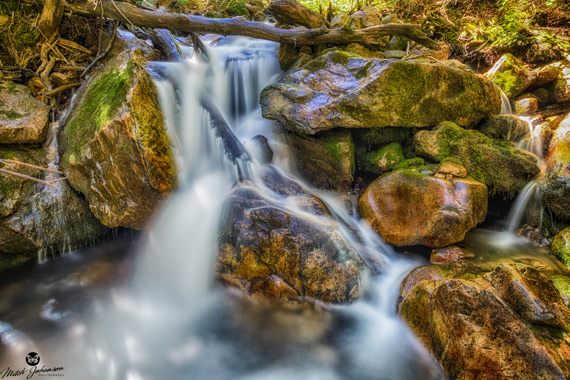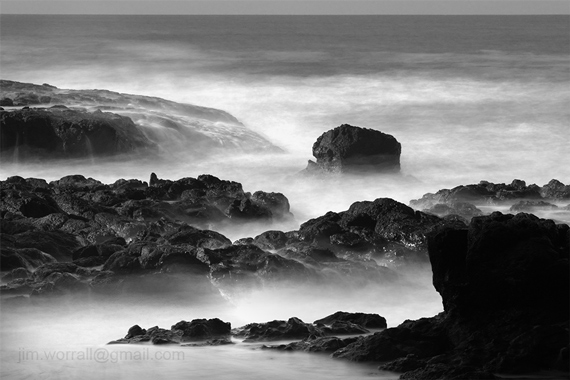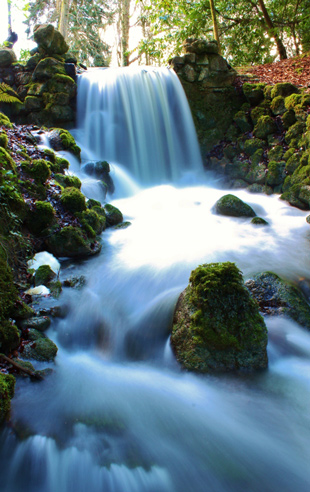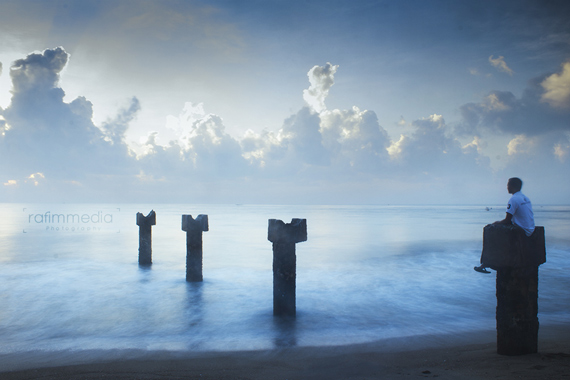Related reminder: sale ending soon for the Photography Action Cards at 88% Off
All of us have seen those amazing, silky, cotton candy seaside scenes or milky, white waterfalls falling down a rock face. They all look so professional and difficult to shoot. Now, equipment may play a small part, but it’s actually simple to shoot moving water. The key is finding the right water to shoot and mastering your technique.

“White Clouds on a Waterfall” by PictureSocial member Mitch Johanson
These scenes can be difficult to photograph well, because a few factors need to be in place. But, once you have them right, you’re on your way to great images. This is a great challenge as you learn digital photography. So what needs to happen? Let’s take a look at some basic steps to getting it right.
1. Choose the right location
The basic foundation for successful flowing water images, especially waterfalls, is choosing the right location for the shot. Waterfalls are notoriously difficult to access, because most times they are found in rugged terrain. Be careful when choosing your location. It’s much better to approach a waterfall from below than from above; look for a route down near the water. By watching the light, you may find there is a perfect time for shooting.

“The Mists of Tea Tree Creek” by PictureSocial member Jim Worrall
2. Choose the right format
Horizontal and vertical formats, also known as landscape and portrait, can both work well for seaside water shots. But, for waterfalls, most times it’s best to use vertical or portrait, because on most occasions there is more height than breadth to the image.

“Waterfall” by PictureSocial member Ian
But be prepared to experiment with both orientations, as you never know which might result in a classic shot.
3. Choose the right shutter speed
To create the milky white or silky smooth water shot, you need to choose the right shutter speed carefully. The variance between 1/30 and 1/15 of a second could be the difference between a great shot and just a good shot. Here, a problem you’ll experience is too much light, which won’t allow you to use a slow enough shutter speed. It may necessitate using a ND gradient or a polarizing filter to reduce the light a little. You’ll need to experiment to get the right speed for the scene and lighting conditions.
4. Use a good tripod
A tripod is essential for water shots, as you may need extended exposure times. This is due mainly to using a small aperture to get maximum depth of field to maintain sharpness throughout the image. Coupled this with a remote or cabled shutter release to reduce camera shake or vibration.
5. Experiment with composition
By this, I mean change your viewpoint, angle, and distance from the waterfall. How much of the waterfall do you want to include versus other features that are near to the water (e.g. moss covered rocks, trees, and other landscape features)? How close you can get to the water due to dangerous obstacles or water spray is another factor you’ll have to contend with. Once you have the composition you are happy with, be prepared to refine it by zooming in or out slightly. A slight variation may improve an image dramatically.

“Looking for Bright Future” by PictureSocial member Mohamed Rafi
Water photography is fun, but it’s also challenging. Be prepared to practice and experiment with locations until you find one that has just the right conditions. Seaside water is far easier to shoot, but you’ll still get some amazing photos. Happy shooting!
About the Author:
Wayne Turner has been teaching photography for 25 years and has written three books on photography. He has produced 21 Steps to Perfect Photos, a program of learner-based training using outcomes based education.
For Further Training, Deal Ending Soon:
Just recently released, The Photography Action Cards, 65 beautifully designed & printable project sheets that will give you over 200 photography assignments covering everything you can imagine. The response has been so big that we asked them to extend their launch sale just a little bit longer for our blog readers, currently 88% off today if you want to try them out.
Each card will retail for $ 5 USD. That means, buying the complete collection individually would cost hundreds. However, for this special early-access offer (to a very select few), you can grab this brand-new training tool for just $ 39! All of it also carries an amazing 365 day happiness guarantee so there is no risk in trying them.
Deal found here: The Photography Action Cards at 88% Off
Go to full article: 5 Tips For Photographing Moving Water
What are your thoughts on this article? Join the discussion on Facebook
PictureCorrect subscribers can also learn more today with our #1 bestseller: The Photography Tutorial eBook
The post 5 Tips For Photographing Moving Water appeared first on PictureCorrect.
